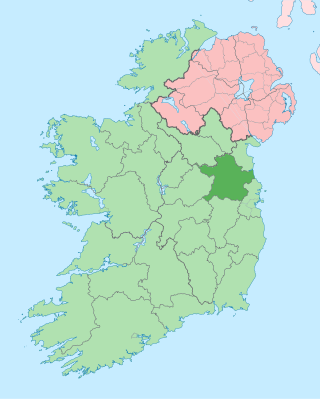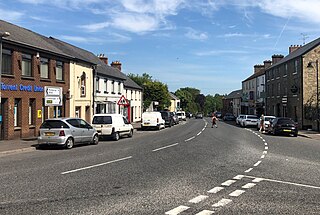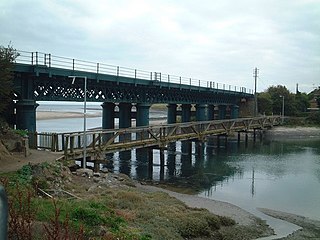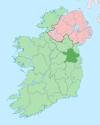
The River Boyne is a river in Leinster, Ireland, the course of which is about 112 kilometres (70 mi) long. It rises at Trinity Well, Newberry Hall, near Carbury, County Kildare, and flows towards the Northeast through County Meath to reach the Irish Sea between Mornington, County Meath, and Baltray, County Louth.

County Meath is a county in the Eastern and Midland Region of Ireland, within the province of Leinster. It is bordered by County Dublin to the southeast, Louth to the northeast, Kildare to the south, Offaly to the southwest, Westmeath to the west, Cavan to the northwest, and Monaghan to the north. To the east, Meath also borders the Irish Sea along a narrow strip between the rivers Boyne and Delvin, giving it the second shortest coastline of any county. Meath County Council is the local authority for the county.

Laytown is a village in County Meath, Ireland, located on the R150 regional road and overlooking the Irish Sea. Historically it was called Ninch, after the townland it occupies. Together with the neighbouring villages of Mornington, Bettystown and Donacarney, it comprises the census town of Laytown–Bettystown–Mornington–Donacarney, which recorded a population of 15,642 in the 2022 census.

Donaghmore is a village, townland and civil parish in County Tyrone, Northern Ireland, about five kilometres (3 mi) north-west of Dungannon. In the 2011 Census it had a population of 1,122 people. The village is beside the River Torrent, formerly known as the Torrent Flow.

Cusack is an Irish family name of Norman origin Cussacq, which is originally from Cussac in Guienne (Aquitaine), France. The surname has diminished in common use in England, but is still common in Ireland, where it was introduced during the Norman invasion of Ireland in the 12th century.
Athboy is a small agricultural town located in County Meath. The town is located on the Yellow Ford River, in wooded country near the County Westmeath border. It is around 15 km west of Navan and 50 km north-west of Dublin. The town is in a civil parish of the same name.

Naul, is a village, townland, and civil parish at the northern edge of the traditional County Dublin in Ireland. The Delvin River to the north of the village marks the county boundary with County Meath. Naul civil parish is in the historic barony of Balrothery West.

The Diocese of Meath is a Latin Church diocese of the Catholic Church that is located in the middle part of Ireland. It is one of eight suffragan dioceses of the ecclesiastical province of Armagh. Thomas Deenihan has been bishop of the diocese since 2 September 2018.

Bettystown, previously known as Betaghstown and transliterated to Beattystown/Bettystown, is a village in County Meath, Ireland. Together with the neighbouring villages of Laytown, Mornington and Donacarney, it comprises the urban area of Laytown–Bettystown–Mornington–Donacarney with a combined population of 15,642 at the 2022 census. During the Celtic Tiger, with increasing property prices in Dublin, Bettystown expanded to cater for large numbers of commuters to Dublin. The area was well known before that as a spot for Dublin summer holiday visitors, with a number of caravan parks and seaside amusements.

Ballygall is a small suburban area located between Glasnevin and Finglas, on the northside of the city of Dublin, Ireland. It is also a townland divided between the civil parish of Finglas and that of Glasnevin. It was settled by Vikings in the 11th century, and later by the Cambro-Normans.

Mornington is a coastal village on the estuary of the River Boyne in County Meath, Ireland approximately 5 km downriver from the centre of Drogheda. Together with the neighbouring villages of Laytown, Bettystown and Donacarney, it comprises the urban area of Laytown–Bettystown–Mornington–Donacarney with a combined population of 15,642 at the 2022 census.

Laytown–Bettystown–Mornington–Donacarney is a built up area in County Meath, Ireland, comprising the adjoining villages of Laytown, Bettystown, Mornington and Donacarney. Prior to 2016, it was listed as Laytown–Bettystown–Mornington.

Kentstown is a village in County Meath in Ireland at the junction of the R153 and R150 regional roads. The village is in a townland and civil parish of the same name.

Rossnaree or Rosnaree is a small village and townland in County Meath, Ireland, 10 km west of Drogheda. The village is on the south bank of the River Boyne, and the Brú na Bóinne complex of neolithic monuments is nearby, on the north bank of the Boyne. Rossnaree commands a ford that was used by the Williamites at the Battle of the Boyne in 1690. The walls of the mill at Rossnaree once contained a Sheela na Gig, although this has been removed for safekeeping and is in private possession.

Donaghpatrick is a village and townland in County Meath, Ireland. It lies approximately 5 km northwest of Navan off the R147 regional road between Navan and Kells on the northern bank of the River Blackwater. The Irish language name of the townland, Domhnach Phádraig, means "the church of Patrick". The local Church of Ireland church, dedicated to Saint Patrick, was built in 1896 close to the site of a much earlier church, and incorporating parts of a medieval tower house. The village is in a civil parish of the same name.
Henry Draycott was an English-born Crown official and judge in sixteenth-century Ireland, who held a number of senior Government offices, including Chancellor of the Exchequer of Ireland. Despite his apparent lack of legal qualifications, he also had a successful career as a judge, becoming a Baron of the Court of Exchequer (Ireland) and Master of the Rolls in Ireland. He became a substantial landowner in the Pale, with his principal estate at Mornington, County Meath.

Erraran (from Irish Airearan, meaning 'Land bordering a Lake' is a townland in the civil parish of Templeport, County Cavan, Ireland. It lies in the Roman Catholic parish of Templeport and barony of Tullyhaw.
Coláiste na hInse, colloquially referred to by locals as The Coláiste, is a co-educational secondary school in Bettystown, County Meath, Ireland. Whilst English is the Coláiste's primary language of instruction, it places an emphasis on the use of Irish on a day to day basis.

St. Colmcille's GAA is a Gaelic Athletic Association (GAA) club based in Piltown, County Meath, Ireland, mainly incorporating the area of Laytown–Bettystown–Mornington–Donacarney. It currently competes in the Meath Senior Football Championship.


















